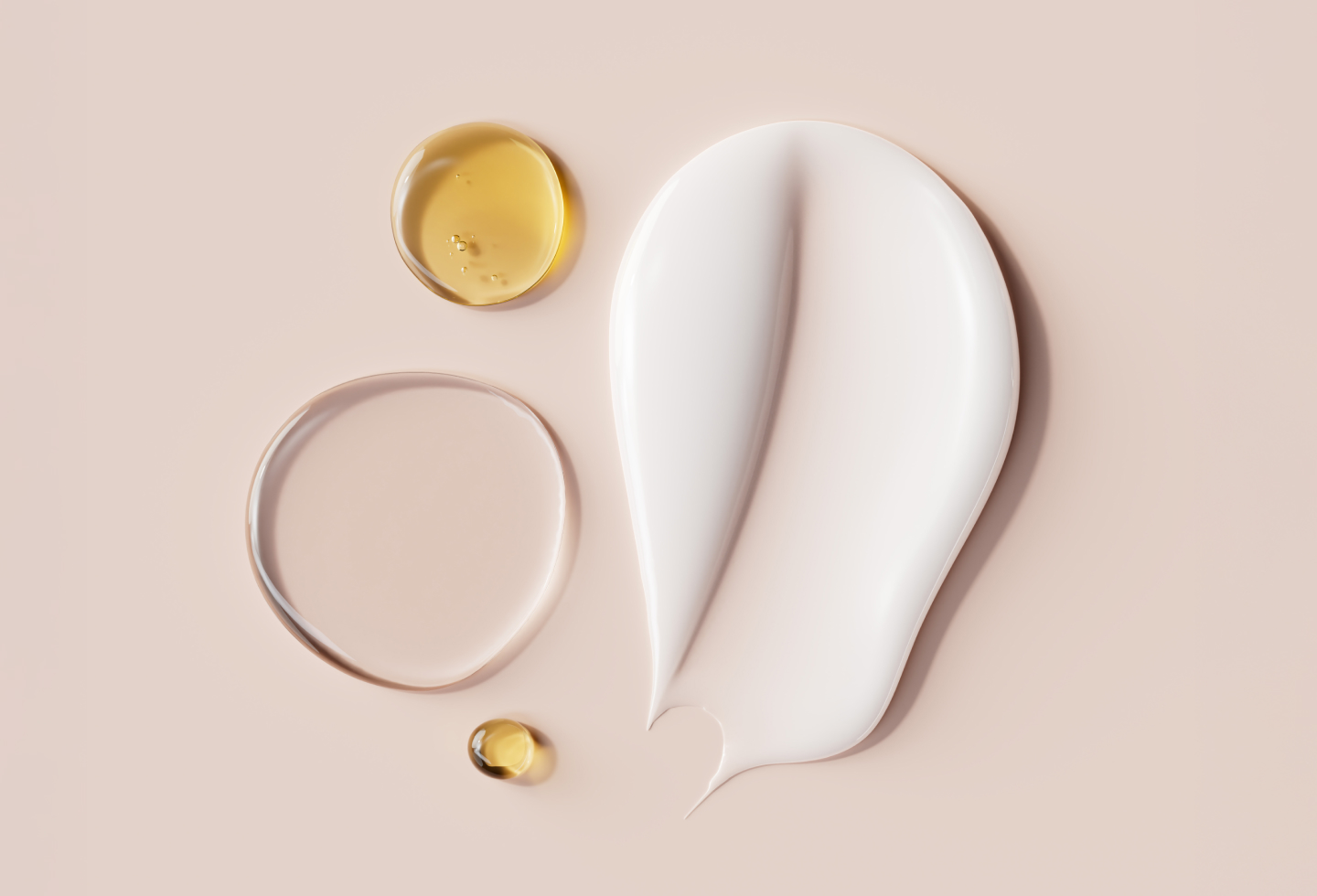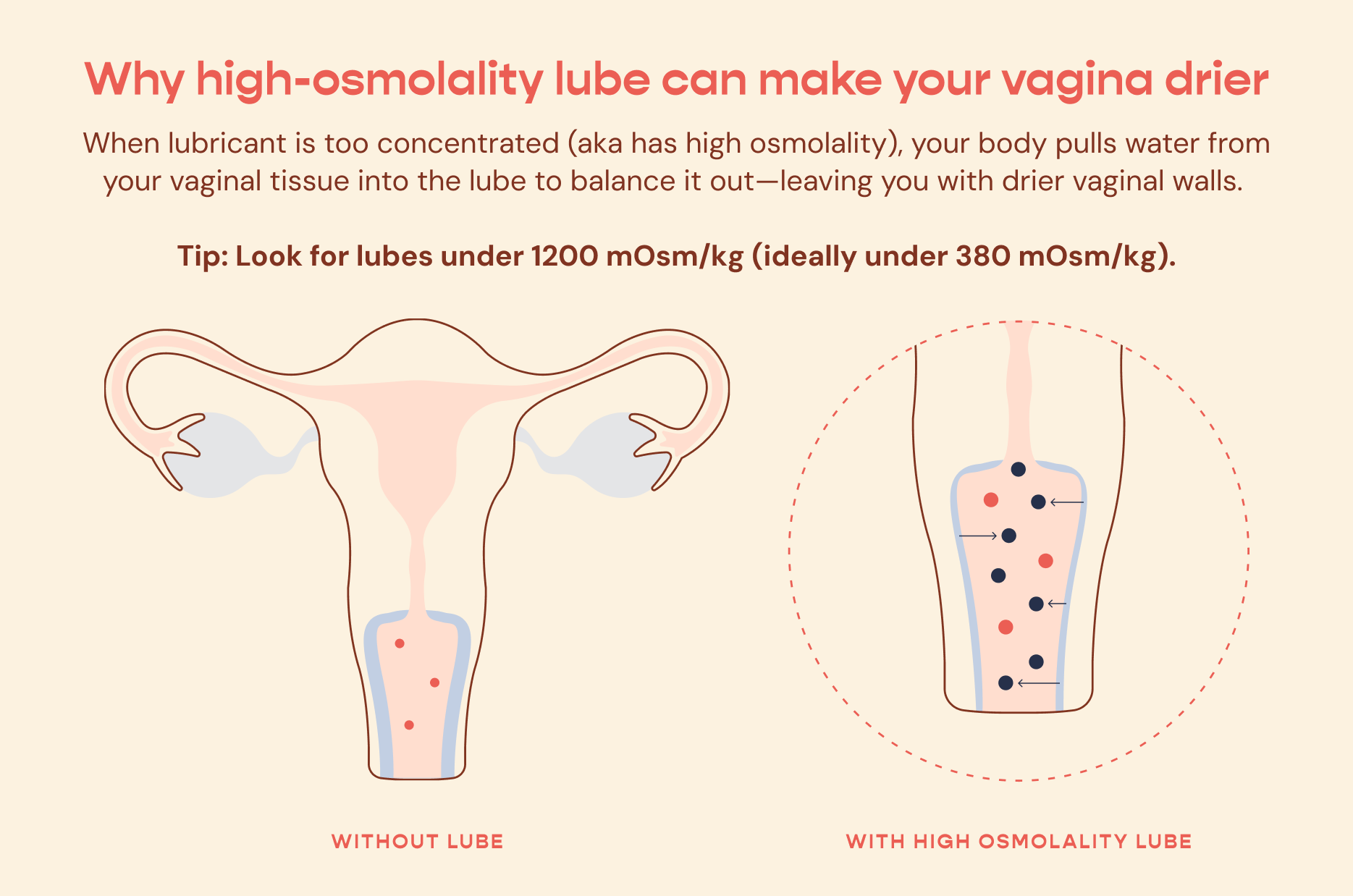
A Comprehensive Guide to Lube, According to Pelvic Floor Therapists
If you've ever thought that personal lubricant is only for solving sexual problems, you’ve been missing out.
Lubricants can enhance sexual pleasure, safety, and comfort for any body, at any age. Pelvic physical therapists help patients with all kinds of sexual health concerns, and everyday, we see how much the right lube can make a world of difference.
But here's the catch: not all lubes are created equal. Some products can cause more harm than good, increasing your risk of everything from vaginal infections to dryness and discomfort. This is why understanding the science behind safe lubrication is so important: time to get nerdy!
Where Sex Meets Science: pH, Osmolality, and the Chemical Balance of Lubricants
Here's where things get technical for a sec, but stay with us: this information may explain why your current lube isn't working for you.
Quick recap from that high school chemistry class you may or may not have snoozed through: pH is a scale that explains how acidic or basic (aka alkaline) a certain solution is.
- A pH of 7 is neutral (think: pure water).
- Values below 7 are more acidic (think: lemon juice or coffee).
- Values above 7 are more basic (think: soap or baking soda).
pH is a logarithmic scale: a one-point change in pH value represents a tenfold increase or decrease in acidity. A seemingly small shift can have a big impact!
Different areas of the human body have different ideal pH values. For example, the healthy adult vagina is moderately acidic with a pH between 3.8 and 5.0. In contrast, a healthy rectum is quite neutral with a pH of 7.
In people with neovaginas, such as transgender women who’ve had bottom surgery, vaginal pH is typically higher than 5.0. The research on the pH and microbiome of the neovagina is still developing. In the few studies published on this topic, researchers find that neovaginal pH can range from 5.88 to 8.0, depending on the surgical approach.
Your vaginal pH levels can fluctuate due to changes in health and hormone levels. As estrogen levels decline during and after the menopause transition, vaginal pH gradually rises, becoming less acidic. Other factors such as infections or sexual activity can also alter vaginal pH.
This means there’s no “one size fits all” when it comes to lubes. You may find that the lube that worked well 10 years ago no longer does the job. If you engage in vaginal and anal sex, you’ll want a different lube for each.
Why does the pH of a lube matter?
Your vagina maintains its pH through a complex ecosystem of beneficial bacteria and other microorganisms: this is its microbiome. These bacteria and the pH they maintain keep your vagina healthy and protect you from infections.
Vaginal pH that’s too high or too low can disrupt the normal microbiome of your vagina. Likewise, when a lubricant's pH is too far from your body’s natural range, it may disrupt your vaginal pH and microbiome.
Lubricant pH is also an important consideration for people who are trying to conceive. Sperm are happiest in a slightly basic environment: a pH between 7.2 and 8.5 is ideal. When pH drops below 6, sperm become less mobile and may struggle to reach an egg for fertilization.
A good rule of thumb: look for a lubricant with a pH that’s as close as possible to the pH of the area in which you’ll use it.
- For vaginal use, look for products with pH between 3 and 5.
- For anal play, a more neutral pH (around 6-7) is preferable.
- If you’re trying to conceive, consider a fertility-specific lube.
What is osmolality, and why does it matter, too?
Osmolality is the measure of how concentrated a water-based solution is: essentially, how many dissolved particles it contains.
Another chemistry class throw-back: when two environments with different particle concentrations come in contact, each tries to balance out the other. The environment with fewer particles sends water over to the concentrated environment to dilute its high density of particles.
Your body's tissues play by these rules, too: they’re constantly trying to maintain water balance with their environment. If you use a lubricant that’s too concentrated, it can literally suck the water out of your vaginal tissues.

This pattern of water exchange can actually make vaginal tissues even drier: the exact opposite of what you’re trying to achieve with lube in the first place!
This is why the World Health Organization (WHO) recommends that lubricants should not exceed 380 mOsm/kg. In practice, though, it’s quite difficult to make a lubricant with an osmolality that low. As a result, the WHO considers an upper limit of 1200 mOsm/kg to be acceptable.
Unfortunately, many commercial lubes far exceed these recommendations, with some products measuring over 3,000 mOsm/kg. For example, Astroglide’s Liquid lube formulation clocks in at over 8,000 mOsm/kg: yikes!
In contrast, you may also run into problems if a lubricant’s osmolality is too low. The more concentrated vaginal tissues can absorb excess water from a less concentrated lube. This may cause swelling of the vaginal walls.
So what’s a discerning customer to do? Fortunately, many lubricants list their osmolality on their packaging or website. All the water-based lubricants on our Products We Love have low osmolalities that meet the WHO’s recommendations.
The Four Main Types of Lubricants (and How to Choose the Right One)
Water-Based Lubricants: Versatile and Easy to Find
Water-based lubes are the most common type you'll find on the shelves of your local store. They feel most similar to your body's natural lubrication and are compatible with all sex toys and barrier methods such as condoms and dental dams.
Best for: First-time users who want an all-in-one option. Anyone using silicone toys or tools. Folks who favor easy cleanup after use.
The downside: These products tend to dry out quickly, so you may need to reapply frequently. They also wash off quickly, which can be a drawback if you’re using lube in the shower. Water-based lubes often contain the longest ingredient lists, which means more potential for vaginal irritation. Many commercial water-based lubes also have problematically high osmolalities that can actually dehydrate your tissues.
Our recommendation: Look for products with low osmolalities and pH levels that match where you’ll use them. Avoid products that contain any of the red flag ingredients in our list below.
Silicone-Based Lubricants: Simple and Long-Lasting
Silicone-based lubricants are often our go-to recommendation for people who need longer-lasting moisture, such as those with vaginal dryness or people who engage in anal sex. They feel thicker and last longer than water-based lubes.
These can also be a good choice for trans women who’ve had vaginoplasty surgery. The tissues used to create a neovagina don’t create their own lubrication, so a thicker, longer-lasting lube can be helpful for folks with this anatomy.
Silicone lubes don't require preservatives and typically don't absorb into your vaginal walls: for most people, this is the closest you’ll find to hypoallergenic lube.
Bonus: silicone lubes are anhydrous, meaning “without water”. Because they are water-free, you don’t have to worry about pH or osmolality!
Best for: Longer sex sessions. Shower or bath play (silicone doesn’t wash off quickly). Those who’d rather not worry about pH or osmolality.
The downside: Silicone lubes are not compatible with silicone sex toys, dilators, or pelvic wands: the lubricant can break down the silicone material. They're also harder to find in most stores: you may need to order online or purchase them from a sex shop.
Pro tip: if you’d like to use a silicone-based lubricant with your silicone dilators or wand, cover the tool with a non-irritating, polyisoprene condom before applying lube. This will protect the tool, and you still get the benefits of longer-lasting moisture!
Our recommendation: This is often our first suggestion for patients dealing with significant vaginal dryness and those who’ve struggled to find a water-based lube that works for them. Since you don’t have to worry about pH or osmolality, silicone lubes can be the best personal lubricant for sensitive skin.
Hybrid Lubricants: The Best of Both Worlds?
These newer products combine water and silicone, aiming to provide longer-lasting lubrication in a formula that’s easier to clean up than full silicone formulations.
Best for: People wanting longer-lasting moisture, such as those enjoying anal sex. Folks who prefer non sticky lube.
The downside: As these are newer on the market, there's less research available about possible long-term effects. Some brands contain other ingredients, such as propylene glycol or glycerin, that can irritate the vaginal lining.
Our recommendation: Hybrid lubes can be a middle-ground option for those seeking a bit more moisture than purely water-based lubes can offer. Read the labels carefully and avoid those with red flag ingredients from our list below.
Oil-Based Lubricants: The Moisturizing Mavens
Some people swear by plant-based oils for their moisturizing qualities. For those who experience dryness and pain due to a medical condition or hormonal changes, for example, organic, virgin coconut oil paste can be a powerful pain relief lubricant.
Unlike some other lubricants, coconut oil isn’t anti-microbial: it doesn’t kill off healthy vaginal bacteria (but it doesn't kill the bad bacteria, either…). Additionally, coconut oil is comedogenic: it forms a thick film over the skin that can cause breakouts and irritation of sensitive skin such as that of the vulva.
Best for: People with vaginal dryness who’d prefer to avoid silicone-based products. Use with sex toys, dilators, or wands when you need longer-lasting lubrication.
The downside: Oil-based lubricants are NOT safe to use with latex or polyisoprene condoms: they will break down the condom and render it ineffective against both pregnancy and sexual transmitted infections (STIs).
Oils can also be problematic for people who are prone to vaginal infections. We need more research to definitively determine if oils do or don’t increase infection risk (Laurie, 2020). Until we know more, consider another lube type if you’re prone to infections.
Our recommendation: Avoid petroleum-based oils and stick with plant-based options such as virgin coconut oil. To avoid contamination, keep any oils you use for lube separate from those you might use for cooking, and only use clean hands/utensils to scoop oil from its container. If you require a barrier method, invest in a non-latex type such as polyurethane condoms (or better yet, switch to a silicone-based lube).
Which Red Flag Ingredients Should I Avoid in a Lubricant?
Sometimes, even lubricants that look good on the outside have bad stuff hiding under the surface. Don’t get duped by marketing claims that a product is good for you just because it’s “natural” or “clean”: you have to read the labels (or hunt down an ingredient list online).
Here are a few common baddies to avoid when choosing your next lube:
Glycerin and propylene glycol
These ingredients increase osmolality, which as you’ve learned, can lead to increased vaginal dryness.
At high concentrations, glycerin may increase your susceptibility to vaginal infections. To maintain a safe osmolality, glycerin (aka glycerol) should make up less than 10% of the total volume of the lubricant.
If the amount of propylene glycol in a lube is low enough (about 8% of the total), it’s unlikely to cause an osmolality problem.
The takeaway: If you’re considering a lube that contains propylene glycol or glycerine/glycerol, make sure it’s one of the last few ingredients listed.
Nonoxynol-9 and chlorhexidine gluconate
Both of these antimicrobial agents kill beneficial bacteria in the Lactobacillus genus, which are crucial for vaginal health. By disrupting the vagina’s natural protective bacteria, these additives may increase the risk of vaginal infections.
1. Benzocaine and other numbing agents
Benzocaine can help delay ejaculation for penis-owners who’d like to last longer. Some manufacturers add it or other numbing agents to lubricants for this reason, but this practice isn’t well-regulated. Benzocaine can irritate vaginal tissue and mask important pain signals that help you avoid injury.
2. Petroleum-based oils
Petroleum products like Vaseline™ may increase the risk of bacterial vaginosis (BV). In addition to being unpleasant on its own, BV may also increase your risk of contracting STIs such as chlamydia or gonorrhea—and who needs that?!?
3. Parabens
No matter what clever marketing might have you believe, any ingredient with "paraben" in the name is still a paraben. These preservatives have weak estrogen-like effects, so it’s possible they could negatively impact the reproductive system and other estrogen-sensitive organs.
Our Lube Recommendations for Every Situation
Remember: each body is unique. As with most things health-related, there’s no single “best lube” for every person or situation. You can use our recommendations as a starting point, but always talk with your pelvic floor therapist for the most personalized advice!
The Best Lube for Postpartum People
First choice: a low-osmolality, pH-balanced, water-based lubricant such as Good Clean Love BioNude
Second choice: a silicone-based product such as Überlube for longer-lasting moisture (great if you’re experiencing dryness related to breast/chestfeeding).
The Best Lube for Vaginal Dryness
First choice: Silicone-based lubricants for long-lasting moisture that won’t irritate
Second choice: High-quality plant-based oils such as organic, virgin coconut oil in paste form
The Best Lube for People with Vaginal Sensitivity or Frequent Infections
First choice: Low-osmolality, pH-matched, water-based products such as Slippery Stuff
Second choice: Silicone-based lubricants for an extra boost of lasting lubrication
The Best Lube for Painful Sex
First choice: Silicone-based lube for long-lasting friction-fighting
Second choice: High-quality plant-based oils such as virgin coconut oil, particularly if dryness is the primary pain driver.
The Best Lube for Anal Play
First choice: Silicone-based lube that lasts.
Second choice: Hybrid water-silicone lubricants for a lighter feel that still gets the job done
The Best Lube for Sex Toys
With silicone-coated toys: Water-based only; avoid silicone lubes!
With glass, metal, or plastic toys: Any type of lube (with appropriate osmolality and ingredients, of course!) can work with these: just clean your toys well before and after use!
When to Seek Professional Help
If you’ve tried every lube under the sun and you’re still experiencing unpleasant symptoms, it’s time to bring in the big guns. Consult your pelvic physical therapist or other healthcare provider if you experience:
- Persistent burning or stinging with any lubricant
- Recurring infections despite changing products
- Pain during any type of sex that doesn't improve with added lubrication
- Other pelvic symptoms that aren’t improving
Your sexual wellness is an important part of your overall health. Don't settle for discomfort or products that cause problems. With the right information and guidance, you can find solutions that work for your unique needs.
Origin’s expert pelvic physical therapists are here to help. If you’re ready for a better sex life, our clinicians are ready to guide you: book your first visit today.
Sources Cited
Abdalla, Sarah et al. “A Comprehensive Review of Plant-Based Cosmetic Oils (Virgin Coconut Oil, Olive Oil, Argan Oil, and Jojoba Oil): Chemical and Biological Properties and Their Cosmeceutical Applications.” ACS omega vol. 9,44 44019-44032. 25 Oct. 2024, doi:10.1021/acsomega.4c04277
Albornoz, Marco A et al. “Virgin Coconut Oil in Paste Form as Treatment for Dyspareunia and Vaginal Dryness in Patients With and Without Rheumatic Autoimmune Diseases: An Efficacy and Safety Assessment Pilot Study.” Cureus vol. 15,6 e40501. 16 Jun. 2023, doi:10.7759/cureus.40501
Hung, Kristin J et al. “Effect of commercial vaginal products on the growth of uropathogenic and commensal vaginal bacteria.” Scientific reports vol. 10,1 7625. 6 May. 2020, doi:10.1038/s41598-020-63652-x
Laurie, Cassandra, and Eduardo Franco. The Potential Harms of Personal Lubricants. 2020, www.bjstd.org/revista/article/view/1270.
Lin, Yen-Pin et al. “Vaginal pH Value for Clinical Diagnosis and Treatment of Common Vaginitis.” Diagnostics (Basel, Switzerland) vol. 11,11 1996. 27 Oct. 2021, doi:10.3390/diagnostics11111996
Potter, N, and N Panay. “Vaginal lubricants and moisturizers: a review into use, efficacy, and safety.” Climacteric : the journal of the International Menopause Society vol. 24,1 (2021): 19-24. doi:10.1080/13697137.2020.1820478
O'Dwyer, Cormac et al. “Vaginal self-lubrication following peritoneal, penile inversion, and colonic gender-affirming vaginoplasty: a physiologic, anatomic, and histologic review.” Sexual medicine reviews vol. 11,3 (2023): 212-223. doi:10.1093/sxmrev/qead015
“Sexual Lubricants: Practice Tips.” British Columbia Medical Journal, 1 Nov. 2024, bcmj.org/premise/sexual-lubricants-practice-tips.
Shabsigh, Ridwan, et al. “RANDOMIZED, PLACEBO-CONTROLLED STUDY TO EVALUATE THE EFFICACY, SAFETY, AND TOLERABILITY OF BENZOCAINE WIPES IN SUBJECTS WITH PREMATURE EJACULATION.” Journal of Men S Health, vol. 15, no. 3, Jan. 2019, p. 80. https://doi.org/10.22374/jomh.v15i3.156.
Stoehr, Jenna R et al. “The microbiome of the neovagina: a systematic review and comparison of surgical techniques.” International journal of transgender health vol. 25,4 623-633. 27 Jul. 2023, doi:10.1080/26895269.2023.2237014
Women’s Voices for the Earth. “Osmolality and pH Properties of Some Commercial Lubricants.” Women’s Voices for the Earth, 10 Jan. 2020, womensvoices.org/osmolality-ph-properties-commercial-lubricants.




